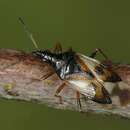en
names in breadcrumbs


The common flowerbug (Anthocoris nemorum) is a common minute pirate or flower bug.[1]
The common flowerbug is found across Europe and the Palearctic to China. [2][3] It is common in Great Britain and Ireland.[1] In the Alps it is found to about 2000 meters above sea level'
It more commonly inhabits lower moist, shaded vegetation than trees, [4] and especially nettles in the later half of the growing season. [5]
Anthocoris nemorum is typically 3–4 mm in length. These bugs have soft elongated flat bodies, with reflective forewings and black pronotum. The legs are mostly orange-brown, with small dark patches close to the tips of the femora. The antennae are mainly orange, with dark tips. In particular, antennal segments I and IV are usually dark, while II and III are pale with dark apices. The front wing is shiny transparent with a distinctive black dot in the center. The membrane shows an hourglass-shaped characteristic black spot at the wing tip. Nymphs of Anthocoris nemorum are dark brown or reddish brown .[4][5]
Adults can be found all year. [6] They are predatory insects, feeding on small insects including greenfly and red spider mites.[1] A. nemorum lays its eggs inside plant leaves.[7] It has been used as a biological pest control since 1992, primarily to control Cacopsylla pyri.[8] It is capable of biting humans.[9]
The common flowerbug (Anthocoris nemorum) is a common minute pirate or flower bug.